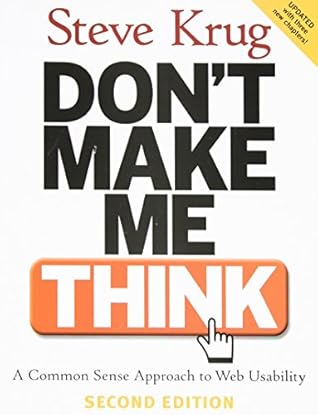More on this book
Community
Kindle Notes & Highlights
Designing, building, and maintaining a great Web site isn’t easy. It’s like golf: a handful of ways to get the ball in the hole, a million ways not to. Anyone who gets it even half right has my admiration.
The point is, when we’re using the Web every question mark adds to our cognitive workload, distracting our attention from the task at hand. The distractions may be slight but they add up, and sometimes it doesn’t take much to throw us.
Making pages self-evident is like having good lighting in a store: it just makes everything seem better.
Web users tend to act like sharks: They have to keep moving, or they’ll die. We just don’t have the time to read any more than necessary.
most of the time we don’t choose the best option—we choose the first reasonable option, a strategy known as satisficing.
(The Back button is the most-used feature of Web browsers.)
Faced with any sort of technology, very few people take the time to read instructions. Instead, we forge ahead and muddle through, making up our own vaguely plausible stories about what we’re doing and why it works.
Create a clear visual hierarchy on each page > Take advantage of conventions > Break pages up into clearly defined areas > Make it obvious what’s clickable > Minimize noise.
Designers are often reluctant to take advantage of them. Faced with the prospect of using a convention, there’s a great temptation for designers to reinvent the wheel instead, largely because they feel (not incorrectly) that they’ve been hired to do something new and different, and not the same old thing.
Since a large part of what people are doing on the Web is looking for the next thing to click, it’s important to make it obvious what’s clickable and what’s not.
When you’re designing Web pages, it’s probably a good idea to assume that everything is visual noise until proven otherwise.
Omit needless words. Vigorous writing is concise. A sentence should contain no unnecessary words, a paragraph no unnecessary sentences, for the same reason that a drawing should have no unnecessary lines and a machine no unnecessary parts.
Back button accounts for somewhere between 30 and 40 percent of all Web clicks.
Don’t confuse a tagline with a motto, like “We bring good things to life,” “You’re in good hands,” or “To protect and to serve.” A motto expresses a guiding principle, a goal, or an ideal, but a tagline conveys a value proposition. Mottoes are lofty and reassuring, but if I don’t know what the thing is, a motto isn’t going to tell me.
It’s not that we think that everyone is like us. We know there are some people out there who hate the things we love—after all, there are even some of them on our own Web team. But not sensible people. And there aren’t many of them.
The more you watch users carefully and listen to them articulate their intentions, motivations, and thought processes, the more you realize that their individual reactions to Web pages are based on so many variables that attempts to describe users in terms of one-dimensional likes and dislikes are futile and counter-productive. Good design, on the other hand, takes this


